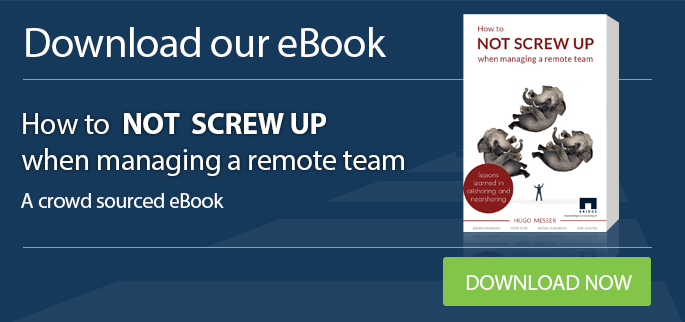3 pitfalls in offshoring and nearshoring3 valkuilen in offshoring ennearshoring
 Few weeks ago, I gave a presentation on our company’s event. The visitors were both experienced offshorers and people planning to offshore their software development. One of the questions that arose was ‘what are the pitfalls in offshoring’. While I could write a book about this (and I actually did), I have a top three:
Few weeks ago, I gave a presentation on our company’s event. The visitors were both experienced offshorers and people planning to offshore their software development. One of the questions that arose was ‘what are the pitfalls in offshoring’. While I could write a book about this (and I actually did), I have a top three:
1. ‘Us versus them’ and ‘Parent-child’ relationships
I see collaborations across geographies go wrong most often when an atmosphere of ‘us versus them’ develops. It is human nature to develop this mentality. We always look at other people as ‘strangers’, especially if they are from another country, religion, city (right?). If not, we wouldn’t have wars. If our aim is ‘collaboration’ and ‘partnership’, we have to be weary of this mentality.
If words arise like ‘those Indians’ or ‘the other guys’, it’s time to talk. The only way to make cross-cultural collaboration work is if it’s about ‘us’ > it’s one team and together we’re trying to achieve something.
A similar pattern is ‘parent-child’, which often arises because of the client-supplier paradigm. We are the client, so what we tell has to get done. And if they say they deliver on wednesday the 25th of May, then they have to, otherwise we’ll fine them. With this attitude, it is very hard to make a collaboration work out for a longer period of time.
2. Not enough preparation
I see companies spend months on RFP’s, selecting the country, talking to vendors, trying to make the right choice. And when the ‘real work’ has to start, they go with what they always did. They organize the work as they have always done locally. They rely on the vendor to show them the way (because the vendor has been doing this for years).
What’s required is a focus on 2 things: selecting the right people and thinking about the’ how’. Everything succeeds if you’ve got the right individuals on your projects. So screen the people (even if it’s a vendor) as thorough as you’d do it recruiting your own local colleagues. And second, once the people are ‘on board’, think about how you are going to communicate and collaborate. Brainstorm on the process (and the way it has to be modified to match the new situation), agree on (coding) standards, fix a meeting rythm of daily and weekly meetings, nail down responsibilities of everyone involved. We’ve developed the ‘Bridge Global Staffing Canvas’ for this, which I can send to you if you drop me an email (h.messer@bridge-outsourcing.nl).
3. The black box approach
When I hear people say ‘outsourcing doesn’t work for us’, I get cautious because I hear ‘outsourcing’. My question is always ‘how did you organize the work?’. And in 99% of the cases, they tell me ‘well, I took a 2-3 months project, specified everything until the smallest detail and agreed on a fixed price and date with my supplier offshore’.
While this way of working is hard with a local supplier, it’s 4 times harder with a remote supplier. In software, it’s hard to specify upfront what needs to be developed. Next, it’s hard to estimate the workload (we’re always optimistic). And then, when requirements and estimate deviate, a lot of communication is needed to agree on the terms for ‘extra work’.
Instead of throwing the requirements into a black box, open up the black box. Choose a process that’s more iterative, scrum based. Ensure you select the people that will do the work for you. Create a flexible collaboration, where agreements can change upon new insights.
 Een paar weken geleden heb ik een presentatie gegeven over ons bedrijfsevent. De bezoekers waren ervaren offshorers en mensen die hun software ontwikkeling offshore plannen. Eén van de vragen die naar boven kwam was ‘wat zijn de valkuilen van offshoring?’. Hoewel ik hier een boek over zou kunnen schrijven (wat ik ook gedaan heb), heb ik hier een top drie gemaakt:
Een paar weken geleden heb ik een presentatie gegeven over ons bedrijfsevent. De bezoekers waren ervaren offshorers en mensen die hun software ontwikkeling offshore plannen. Eén van de vragen die naar boven kwam was ‘wat zijn de valkuilen van offshoring?’. Hoewel ik hier een boek over zou kunnen schrijven (wat ik ook gedaan heb), heb ik hier een top drie gemaakt:
1. ‘Wij tegen hen’ en Ouder-kind’ relaties
Ik zie samenwerkingen over landgrenzen mis gaan wanneer er een ‘wij tegen hen’ atmosfeer ontstaat. Het is menselijk om deze mentaliteit te ontwikkelen. We kijken altijd naar anders mensen als ‘vreemden’, vooral als zij uit een ander land of stad komen of een andere religie hebben (toch?). Zo niet, dan zouden we geen oorlogen hebben. Als ons doel ‘samenwerken’ en ‘partnerschap’ is, moeten we voorzichtig zijn met deze mentaliteit.
Als woorden zoals ‘die Indiërs’ of ‘de anderen’ ontstaan, dan is het tijd om te praten. De enige manier om de samenwerking goed te laten verlopen is als we het hebben over ‘wij’ > het is één team en samen proberen we iets te bereiken.
Een gelijksoortig patroon is de ‘ouder-kind’ relatie, die vaak ontstaat vanwege de client-leverancier paradigma. Wij zijn de client, dus wat wij zeggen, moet gedaan worden. En als zij zeggen dat ze op woensdag 25 mei moeten leveren, dan moeten zij dat ook anders krijgen ze een boete van ons. Met deze houding is het heel lastig om een goed samenwerkingsverband op te zetten voor een langere periode.
2. Niet genoeg voorbereiding
Ik zie bedrijven maanden spenderen aan RFP’s, het selecteren van het land, praten met leveranciers, proberen de juiste keuze te maken. En wanneer het ‘echte werk’ gedaan moet worden, gaan ze verder zoals ze altijd al deden. Ze organiseren het werk zoals ze dat lokaal ook altijd gedaan hebben. Ze vertrouwen op de leverancier om hen de weg te wijzen (want de leverancier doet dit al jaren).
Wat nodig is, is focus op 2 dingen: het selecteren van de juiste mensen en het denken aan de ‘hoe’. Alles zal goed komen, zodra u de juiste individuen op uw project hebt. Dus screen de mensen (ook al is deze leverancier) zo goed mogelijk net zoals u zou doen tijdens het werven van uw eigen lokale collega’s. En ten tweede, zodra de mensen ‘on board’ zijn, denk er dan over na hoe u gaat communiceren en samenwerken. Brainstorm over het proces (en hoe deze aangepast moet worden voor nieuwe situaties), overeenstem de (coding) standaarden, regel een meeting ritme van dagelijkse tot wekelijkse meetingen, verdeel de verantwoordelijkheden van iedere betrokkene. Wij hebben hiervoor de ‘Bridge Global Staffing Canvas’ ontwikkelt, die ik u kan sturen als u mij een email stuurt (h.messer@bridge-outsourcing.nl).
3. De black box aanpak
Wanneer ik mensen hoor zeggen ‘outsourcing werk niet voor ons’ word ik voorzichtig om ik ‘outsourcing’ hoor. Mijn vraag is altijd ‘hoe organiseert u uw werk?’ En in 99% van de gevallen vertellen ze me ‘nou, ik nam een 2-3 maanden project, tot in de details alles gespecificeerd en overeengekomen over een vaste prijs en datum met mijn leverancier offshore’.
Hoewel deze manier van werken al moeilijk is met een lokale leverancier, wordt het nog een 4 keer zo moeilijk om zo te werken met een remote leverancier. Met software is het moeilijk om van te voren precies te specificeren wat ontwikkelt moet worden. Daarnaast is het moeilijk om de workload in te schatten (we zijn altijd optimistisch). En wanneer de eisen van de schatting afwijken is er veel communicatie nodig om overeenstemming te bereiken over de voorwaarden voor ‘extra werk’.
In plaats van de eisen terug in een black box te gooien, open de doos. Kies een proces dat meer iteratief is, scrum gebaseerd. Wees er zeker van dat u mensen selecteert die het werk voor u willen doen. Creëer een flexibele samenwerking, waar overeenkomsten kunnen veranderen dankzij nieuwe inzichten.



